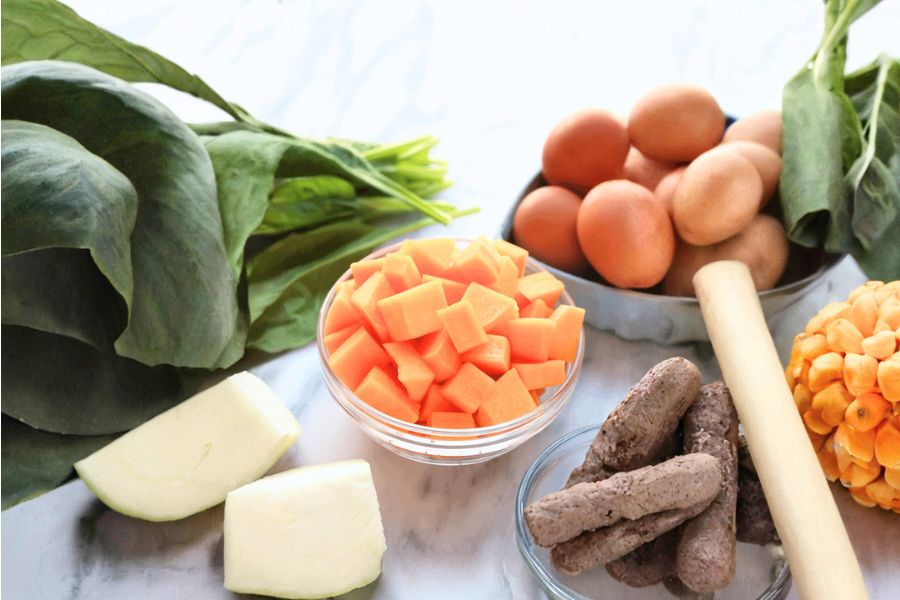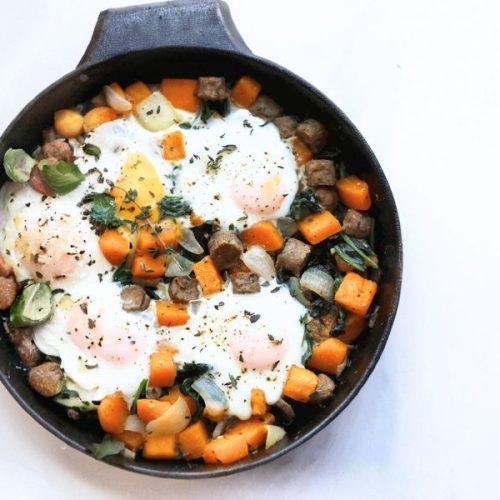This butternut squash breakfast hash is a nourishing, satisfying start to the day, combining hearty vegetables, lean protein, and farm-fresh eggs in one skillet.
The natural sweetness of butternut squash pairs beautifully with savory turkey sausage and aromatic thyme, delivering a comforting fall-inspired flavor.
With leafy spinach for vitamins and fiber, and avocado oil for healthy fats, this dish is both wholesome and energizing.
It’s high in protein, lower in carbs than traditional potato hashes, and rich in nutrients to keep you full for hours.
Best of all, it’s a one-pan meal that comes together quickly — ideal for busy mornings or simple meal prep during the week.

Whether you bake or pan-fry the eggs, it’s an effortlessly impressive dish that tastes like a cozy weekend brunch any day of the week.
Must-Have Tools for Perfect Results
Cast Iron Skillet
Allows for even browning and retains heat beautifully to cook the squash perfectly. A durable kitchen staple ideal for stovetop-to-oven meals.
Chef’s Knife
Essential for cubing squash and chopping vegetables quickly and safely. A sharp, reliable knife makes prep faster and far more enjoyable.
Wooden Spoon or Spatula
Perfect for sautéing ingredients without scratching your pan. Great for stirring onions, squash, and sausage evenly.
Measuring Spoons
Ensures precise seasoning — especially with herbs and oil — for balanced flavor every time.
Lid for Skillet
Crucial for steaming/frying the eggs evenly without overcooking the rest of the hash. Also useful for countless one-pan recipes.

30-Minute Butternut Squash Breakfast Hash
Equipment
- 1 Cast Iron Skillet
- 1 Sharp Chef’s Knife
- 1 Cutting Board
- 1 Wooden spoon or spatula
- Measuring Spoons
Ingredients
- 2 tablespoons avocado oil
- 2 cups cubed butternut squash
- ½ yellow onion chopped
- 6 pre-cooked turkey sausage links sliced
- ½ tablespoon minced garlic
- 1 tablespoon fresh thyme minced
- 2 cups fresh spinach chopped
- 4 large eggs
- Salt to taste
- Pepper to taste
Instructions
- Warm the Pan & Add Oil: Place a large cast iron skillet on the stove over medium-high heat. Allow it to heat up for a minute or two so it’s evenly hot. Add the avocado oil and swirl to coat the bottom of the pan.You’ll know it’s ready when the oil glistens and becomes slightly fragrant — this prevents the squash from sticking and helps it caramelize beautifully.
- Sauté the Butternut Squash: Carefully add the cubed butternut squash to the skillet. Use a wooden spoon to spread the squash into a single layer so each cube touches the surface. Cook for about 5 minutes, stirring every minute or so. The squash should begin to soften and develop golden-brown edges, which adds a subtle sweetness and hearty texture to the dish.
- Add Onion for Flavor: Once the squash starts to brown, toss in the chopped yellow onion. Stir to combine, letting the onion cook alongside the squash for another 5 minutes. During this time, the onion will soften, turn slightly translucent, and infuse the squash with savory flavor.Continue stirring occasionally to avoid burning and to ensure even cooking.
- Incorporate Sausage, Garlic & Thyme: Add the sliced pre-cooked turkey sausage to the skillet. Sprinkle in the minced garlic and fresh thyme. Stir well so the sausage can warm up and the garlic becomes fragrant — this usually takes 1 to 2 minutes. This step adds a savory, aromatic depth to the hash, and the thyme gives it an earthy, cozy, fall-inspired flavor.
- Add Spinach & Wilt: Reduce the heat slightly to medium. Add the chopped spinach to the skillet. It may seem like a lot at first, but spinach wilts down quickly. Stir and cook for 3 to 5 minutes until the spinach is fully wilted and combined with the rest of the ingredients. This adds a nutritious, vibrant green element to your hash.
- Create Egg Wells: Use the back of a spoon to make four small “wells” or divots in the skillet mixture. These are little pockets where the eggs will sit so they cook neatly without spreading across the entire pan. Make sure each well reaches the bottom of the pan so the eggs cook evenly.Add and Cook the Eggs: Crack one egg into each divot.
- To Bake the Eggs: Preheat your oven to 350ºF (175ºC) before you begin cooking. Once the eggs are added, transfer the entire skillet into the oven and bake for 15–20 minutes or until the eggs reach your desired doneness.
- To Fry the Eggs: Leave the skillet on the stovetop. Lower the heat to low or medium-low and place a lid over the skillet. Let the eggs cook for 7–10 minutes, or until the whites are set and the yolks are cooked to your preference. Both methods work wonderfully — choose baked eggs for a hands-off approach and firmer whites, or stovetop fried eggs if you prefer softer, slightly runny yolks.
- Final Seasoning & Serve: Once the eggs are cooked, remove the skillet from the heat. Sprinkle salt and pepper to taste over the entire dish, focusing on the eggs and squash. If desired, garnish with extra thyme or a sprinkle of red pepper flakes for light heat.Serve the hash straight from the skillet for a rustic presentation. Enjoy immediately while hot!
Notes
- You can substitute sweet potatoes for butternut squash for a flavor twist.
- Use chicken sausage or plant-based sausage if preferred.
- For a spicy kick, add red pepper flakes or smoked paprika.
- Cook eggs longer if you prefer firmer yolks.
- Double the recipe in a larger skillet for meal prep breakfasts.
Chef’s Secrets for Best Flavor
One of the biggest keys to a truly delicious hash is letting the butternut squash caramelize without rushing it.
Take the full five minutes (or more) in the beginning to allow those cubes to brown — that golden crust brings out their natural sweetness and adds texture.
Also, always add garlic after the onions have softened; garlic burns quickly and turns bitter if added too early.
If using pre-cooked sausage, make sure it browns slightly in the pan so it develops flavor rather than just warming through.
Lastly, fresh thyme really elevates this dish over dried — the fragrance it releases in the skillet makes a surprisingly big difference.
Serving Suggestions for Every Occasion
This hash is hearty enough to enjoy on its own for breakfast or brunch, but it pairs wonderfully with a slice of toasted sourdough or whole-grain bread.
For a weekend brunch spread, serve it alongside fresh fruit, Greek yogurt, or a light salad for a balanced meal.
You can also top each serving with avocado slices or hot sauce for added creaminess or heat.
If serving for lunch or dinner, pair it with a simple mixed greens salad or roasted vegetables to keep it wholesome and satisfying.
Storage Tips and Reheating Advice
Leftovers keep very well! Allow the skillet to cool completely, then transfer the hash (minus the eggs, if possible) into an airtight container and refrigerate for up to 3–4 days.
To reheat, simply warm in a skillet over medium heat until heated through, or microwave in short bursts.
If storing with eggs, note that the yolks may become fully firm when reheated.
You can also prepare the vegetable and sausage base in advance and cook the eggs fresh when ready to serve.
This makes the recipe ideal for meal prep in busy weeks.
Frequently Asked Questions About This Dish
Can I make this vegetarian?
Absolutely! Just swap the turkey sausage for a plant-based sausage or add extra vegetables like mushrooms or bell peppers for more texture and flavor.
Do I have to use a cast iron skillet?
No, any large nonstick or stainless steel skillet will work. Cast iron simply provides the best heat retention and caramelization.
What can I use instead of fresh thyme?
Dried thyme can be used if that’s what you have. Use about ½ teaspoon dried thyme instead of 1 tablespoon fresh.
Can I use frozen butternut squash?
Yes, frozen squash will work in a pinch. Just thaw it and pat dry before cooking so it doesn’t release too much water in the pan.
What if I want runny yolks?
For stovetop eggs, start checking them around 6 minutes and remove from heat early. For baked eggs, take the skillet out closer to 12–13 minutes.
This recipe has been adapted and simplified from the original version by fitfoodiefinds. We’ve refined the steps for a smoother cooking experience and added helpful notes, nutrition insights, and essential kitchen tools to make it even easier for home cooks.

